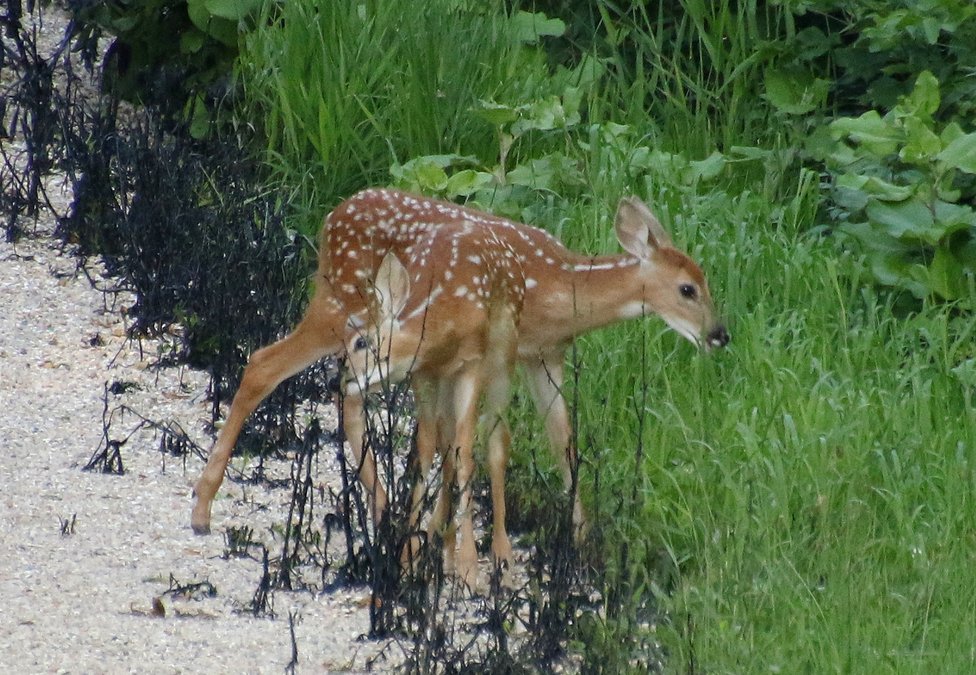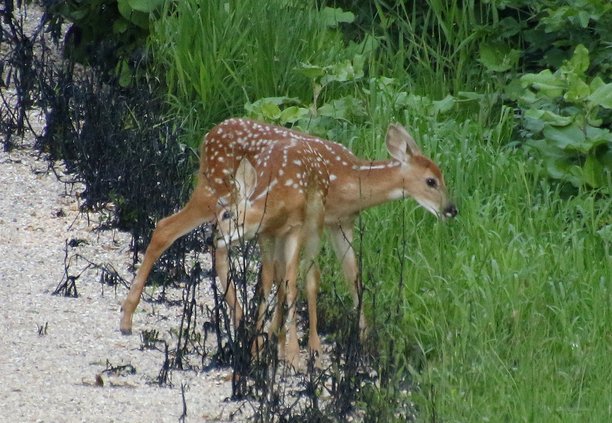Heavy rains ended June and continued early July rutting country roads and lanes, tipping huge lowland Angelica plants, and sending corn head high camouflaging anything traveling among the stalks.
“One of the most noticed features from precipitation is the abundance and size of wildflowers, particularly in the prairies and along the roads,” said Doug Williams, at D W Sports Center in Portage, Wisconsin.
Fern fronds have made deciduous forests look tropical. Some potatoes, tomatoes, onions, squash, cucumbers and watermelons may slowed growth of edible plant organs and put the energy into more vegetative tissues.
Yellow coneflowers, purple beebalm, and milkweed are attracting bees, dragonflies, and butterflies while some oaks, apples, aspens, and black cherries dropped their idea of fall fruit to concentrate replacing caterpillar-eaten leaves.
White-tailed deer continue their rapid changes with fawns feeding, attractive coats appearing and fuzzy antlers elongating. All deer are now dwarfed by maize.
The Wisconsin Department of Natural Resources is beginning to inform deer hunters, watchers, enthusiasts, farmers, and anyone else who is directly, indirectly, or inadvertently involved in the eight fall hunting seasons. The early news centers on the animal, habitat, and disease, not the hunt itself. This makes is even more useful for non-hunters, too.
Understanding a little bit about deer and deer hunting will make understanding hunters and hunts much easier, safer, and enjoyable for all of us.
Realize first that deer and the eight seasons touch nearly everyone in some way, economically, recreationally, inconveniently, and being a spectator. During the November season traffic crowds roads, phone lines, store aisles, state parks, convenience stores, bars, restaurants and public hunting grounds parking lots during peak hunting.
The overload of early news releases is necessary to get it all in before that November event. Just as important, there are things most hunters need to do to be ready with licenses, authorizations, equipment, clothing, land contacts, and vacation scheduling.
Non-hunting recreationists need to prepare, too. Photographers and deer viewers in general are aware of summer coat color changes, antler growth, velvet shedding and the mating season when bucks appear almost anywhere, at any distance, and frequently in a driver’s headlights.

These eight seasons extend from September 14 to January 31, 2025. This 140-day span is an open season for archery and crossbow metro sub-units and counties with extended archery seasons. Most seasons, however, are much shorter as with the two-day youth deer hunt and the granddaddy, a nine-day gun deer season, which this year is the latest it can possibly be by November’s calendar.
The general Archery and Crossbow (Sept. 14 - Jan. 5, 2025); Gun hunt for hunters with disabilities (Oct. 5 – 13); Youth deer hunt (Oct. 5 – 6); Gun hunt (Nov.23 – Dec. 1); Muzzleloader (Dec. 2 -11); 4-Day antlerless-only (Dec. 12 – 15); and Antlerless-only holiday hunt (Dec. 24 – Jan. 1) rounds out the list.
The WDNR overloads the internet with releases, so picking and choosing where and how you hunt and observation can focus interest and make choices easier. A hunting regulations pamphlet and a game survey report will be released before the seasons commence.
The term antlerless pops up regularly, which means any white-tailed deer with no antlers or neither antler three inches long or longer. In other words, a buck deer has at least one antler that is three inches or longer in length.
As in past seasons, putting a “tag” on a deer is not required, but a printed authorization is used to declare the possession is legal.
It’s not too early to purchase a license, according to Williams. “Supplies, too, and it’s not a sales pitch, are going to run out and prices keep going up.”
An early WDNR release begins by informing the public, anyone interested in deer, and hunters and non-hunters, about deer population objectives across the state. Every county has a deer advisory council to increase local involvement in deer management decisions.
Deer enthusiasts may stay informed regarding research, which is discussed and reported from time to time on populations, the meaning of the sex-age-kill model used by population biologists, the winter severity index, surveys being conducted, health of the herd, and a stakeholder group that holds an open discussion with the DNR to brainstorm ideas in deer management.
This is enough to keep informing an inquiring mind towar Wisconsin’s state wildlife animal.
Insects continue to dominate, interfere, interest and dictate some activities. Gnats, mosquitoes, dragonflies, butterflies, pollinators, disease vectors, biting and stinging bugs, and entertainers are in our lives.
Michigan lily, large and small mushrooms, golf ball size walnuts, poisonous pokeweed, stickseed, ginseng fruit balls, rattlesnake plantain, and corn flowers are a few summer showoffs standing for attention.
Contact Jerry Davis, a freelance writer, at sivadjam@mhtc.net or 608.924.1112.









